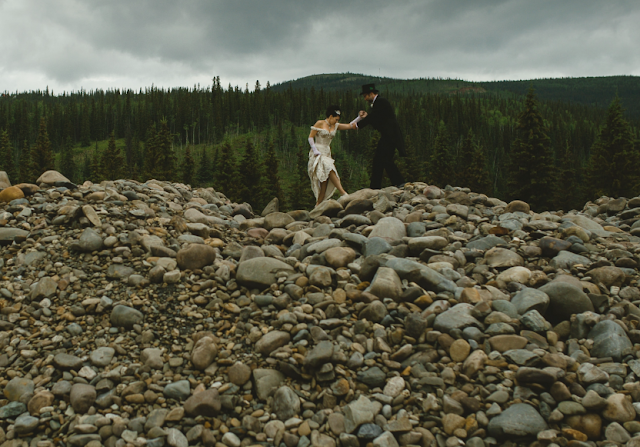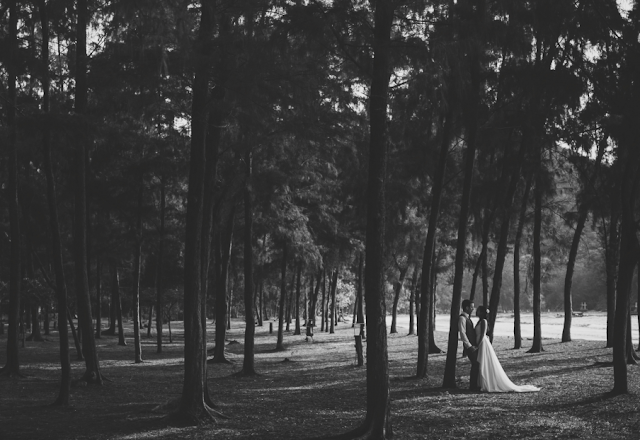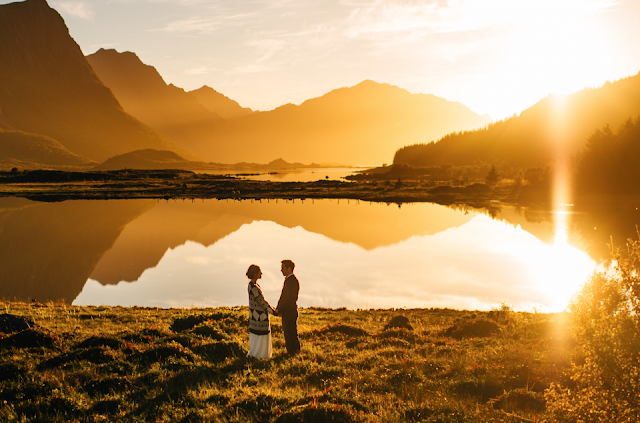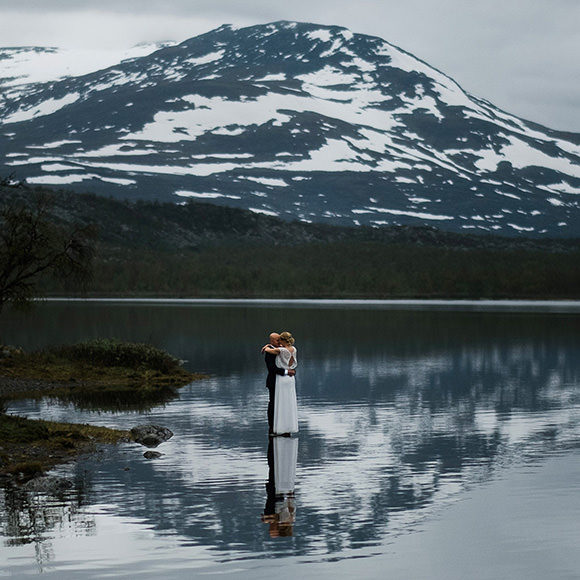Ask An Artist
- Cole Roberts
For this task I have been researching the work of a Swedish artist named Cole Roberts. Cole is one half of the highly successful photography company Nordica Photography. He is mainly based within the wedding photography sector, however a vast number of his photographs are based within natural landscapes and try to capture the aspect of isolation, therefore, his images fit my theme perfectly.
Artist's Photographs

Due to Cole being an international photographer much of his work is based overseas in varied locations worldwide. The above photograph was taken in Canada, and although the couple are fairly close to the camera, Cole still manages to capture the isolation factor within the landscape by positioning himself lower than eye level. He keeps the background simple in order that we focus completely on the couple and as the couple are not 'posed' in the frame, we get the opportunity to wonder at their conversation as they clamber over the boulders. I like the way the horizon in the photograph is lifted giving us a larger view of the stones. This creates great texture to the photograph and gives the impression that walking across this vast beach is quite difficult, especially in a wedding dress. This then validates the man's gestures of help to his wife and provides the viewer with a guessed narrative to accompany the image.

The second image which I have chosen to represent my theme, taken by Cole Roberts is the above shot. It was captured in Southern Thailand. Although this image does indicate a beach setting to the right of the photograph, it concentrates more on alternative natural beauty by using woodland as a backdrop for the photograph. Cole uses the rule of thirds to compose his shots perfectly, capturing the emptiness of the landscape by positioning the couple to the far right hand side. The trees draw our eyes through the photograph, yet the couple are still prominent and very much the focus of the frame. I think that shooting this in black and white ensures that the brides dress is highly visible and Cole often uses this technique to ensure our eyes are drawn to to the couple first before then admiring the setting.

The third artist image chosen is a photograph which mainly focuses on the landscape and surroundings, rather than the people involved. This time, Cole has focused of the surrounding natural light to create a breathtaking backdrop for the couple featured. This photograph was taken in Norway, and shows the photographers professional skill when using light and silhouettes and the reflections of the mountains create drama and give an almost dream like quality to the image. This symmetry of the mountains and their reflection in the water create a perfect composition for the photograph, however, although the setting is so picturesque, the couple are fixed on each other rather than their surroundings. I was drawn to this image due to the exceptional use of light and I really enjoyed the overall atmosphere this light provides to the photograph.

A Further photograph taken with an amazing use of backdrop and reflection is the above image taken by Cole Roberts for a wedding in Norway. I chose this image as it again shows perfect balance and composition of shot. The couple are almost floating on the water in this image as the rock they are standing on is completely hidden from view. The use of reflection is very effective for not only the couple's image is mirrored in the water below but the mountain scenery used as their backdrop is also shown in the lake. Isolation is very apparent and as the couple do not look at the camera, we feel, as a viewer, that they are completely alone sharing a special moment.
The Questions Asked.
When interviewing Cole, I decided to base all of my questions around the use of isolation as this was a strong recurring theme within his photographs. I was also keen to explore the types of work the artist was inspired by which could give me further insight into my topic.
- Q - "Do you purposely try and create isolation within your photography, or is this just a style which you have adopted in your shots based on the surrounding landscape?"
"Well, a wedding is broken into the portraits portion, and “everything else”. The “everything else” is basically interpreting the day as it unfolds and remaining hands off, so it’s tough to say whether that’s purposely isolated or landscape focused. But when it does come time for portraits, it really depends on the wedding, location and time of day for the portraits. The rule of thumb is to go for great light over a great location - even if you’re in Iceland or another dramatic location - so that’s the first thought. Afterwards comes location and generally speaking, stepping back and letting the frame tell the story involves bringing in the natural elements."
- Q - "When did you first become a professional photographer and has photography always been a passion?"
"The end of 2009 was when I quit everything and went all-in with photography. My business partner moved over from Europe to Vancouver, and we completely focused on making it work. It was intended to be a one-year project, but grew quite quickly so we went with it.
Photography definitely has not always been a passion for me. My parents started a photo lab in the early 90s, and my mother has been a professional since the 70s. So straightaway I was sort of wrangled into it at a young age, and wasn’t exactly a fan. Growing up, my focus was totally on hockey, so it’s a bit ironic how things unfolded. But around 2008, I got the bug, started photo blogging, and the rest is history."
- Q - "Has there been a certain artist which you have followed that gives you inspiration or do you just shoot what feels right?"
"I almost never look at other wedding photography, so can’t say I am influenced in any way from people within our genre. The most influential photographer for me definitely is Ragnar Axelsson, and oftentimes when I view his work, there is isolation and a bit of reclusion which I love. Tough to bring that into a wedding day though, so I would say I tend to just photograph whatever is in front of me and not overthink it."
- Q - "Is Photoshop (or similar programme) a piece of software you use on a regular basis to enhance you photographs, or do some photos just speak for themselves?"
"We use Lightroom to edit everything, but our editing is very light. We feel a timeless image should not be overly edited, and we feel people hire us for our vision and not editing (albeit we realize editing is important so we do not understate quality post-processing)."
- Q - "Do you ONLY focus on wedding photography or will you tackle any project given?"
"Our brand only speaks to weddings and that’s completely intentional. We would rather be known as masters in one thing as opposed to a jack of all trades. In saying that, you name a genre of photography and we’ve done it, but we simply do not show it anywhere online or elsewhere."
Further Images Taken By Nordica Photography














































